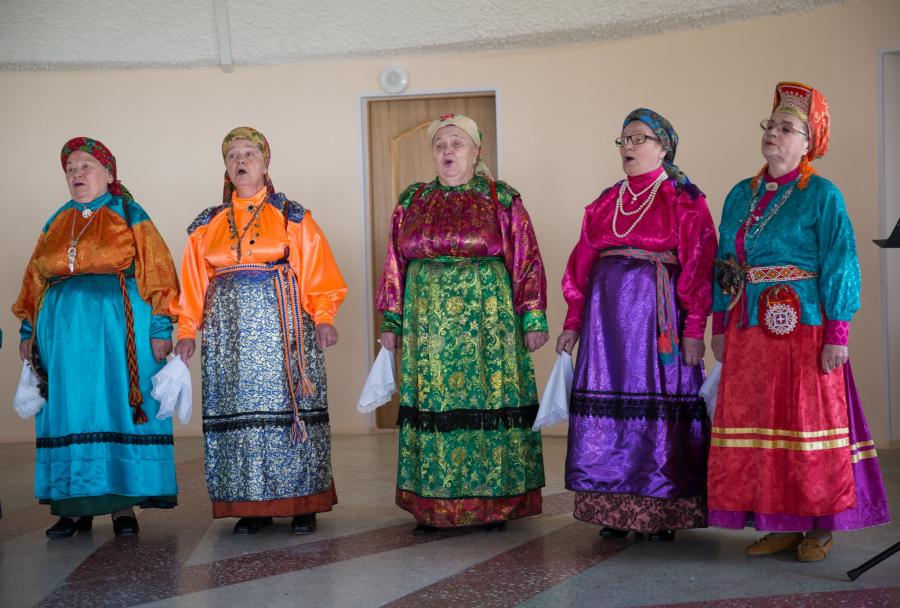Tourism threatens the cultures and environments of indigenous communities all over the world. The Buryat and Soyot of Siberia—not normally considered a hot tourist destination—are among those concerned about the growing number of visitors to their important cultural and ecological areas.
When a group of ecologists and cultural arts experts from New York State's Adirondack Park traveled in September 2003 to meet with Buryat and Soyot foresters, administrators, and ecologists, they were pleasantly surprised to find that they felt quite at home in the familiar climate and among the hills and mountains turned gold and red by autumn leaves. The trip completed an exchange program organized by the Totem Peoples’ Preservation Project, a Cultural Survival Special Project, and supported by the Association for the Protection of the Adirondacks, that started with visits from Buryat experts to Adirondack Park in 1998 and 1999.
The similarities in landscape helped the two groups come together to discuss the environmental, cultural, and social threats that all the delegates had seen their homelands face. Both groups have seen the impact of isolation and a seasonal economy; the benefits and challenges of living in a protected landscape owned by both the state and private citizens; the threats of industrial pollution; the desires to increase tourism; the steady loss of rural youth to urban areas and distant cities; the need to protect the environment and open vistas while bringing in energy, technology, and communication services; caring for the elderly and meeting health and social services needs; and the need to provide quality education for young people and retrain adults to meet the rapid changes in society. The Adirondack Park has been dealing with the effects of development for more than 100 years and now has 8 million visitors pass through the region every year. The relatively young Tunkinsky National Park was established in 1991, and currently has 150,000 visitors per year. Its administrators see an influx coming, however, and want to be ready to deal with the impacts it will have on the region’s ecology and Native culture.
“There are a lot of similarities between our parks, but Adirondack is older,” Yanzhima Vaseleva, a Native Buryat trained in forestry and non-timber forest products and director of the Itegelov Project supporting Buryat Buddhist traditional revival, told the American delegation during a meeting with administrators of Tunkinsky National Park. “For us [at Tunkinsky] not to make mistakes, it would be good for us to take lessons from you. We are at the beginning of a very important way of working. In Russia such parks have only been studied for 10 years so your great experience will help us in developing this park. Your information will help us so we can solve our problems more quickly.”
Mineral springs in both the Tunka and Oka regions have been designated as sacred sites, and Buddhist temples and shamanistic sites have been erected along roadways in historically important areas, drawing those who follow the region’s two major religions. And while the Adirondack team had extensive experience in land-use planning and ecological conservation, they learned a great deal from their Buryat colleagues about maintaining the cultures of people indigenous to those lands.
“We haven’t done very well with recognizing Native people in our park,” Dan Plumley, coordinator of the Totem Project, told his Buryat colleagues. “You can help us in understanding how to protect Native people in a protected area. You have honored your histories in your park, and this is something our park hasn’t done for our Native Americans.”
During the exchange the Adirondack and Buryat delegates also met with town and regional administrators in Tunka and Oka, shared presentations with students of a forestry college in Ulan Ude, the capital of Buryatia, and visited with Buddhist leaders throughout the region.
At the close of the two-week exchange, Buryat and Adirondack delegates wrote a protocol summarizing the work they had accomplished and laying out the groundwork for future cooperation. The protocol focuses on joint efforts to collaborate, share experiences, and offer mutual ideas and aid in fostering the protection of Native ecological and cultural resources and characteristics of each delegation’s homeland park region.
Prompted by the his visit and ecological tour with Noyon Ecological Club, an ecology program for youth in the Selenginsky Region of Russia, Adirondack team member Carl George has collected a compound, binocular, and research scope from the biology department at Union College in Schenectady, New York, where he is professor emeritus. Noyon will use the equipment to study the effects of development on the health of Shuchi Ozera (Pike Lake), a popular tourist destination that is suffering from runoff pollution and a decreasing water level.
Inspired by the strong presence of cultural arts in Buryatia, Naj Wikoff, an artist who represented the Adirondacks on the exchange, returned in May to help develop an exchange that will bring hospitals and artists in Buryatia and the Adirondacks together to promote healing through the arts.
The Totem Project and the Association for the Protection of the Adirondacks is planning its next major delegation exchange to Buryatia for July 2005 to focus on preserving cultural arts, music, and traditions.
For more information, or to support the Totem Project's cultural exchange effort, contact coordinator Dan Plumley at the Totem Peoples’ Preservation Project, P.O. Box 746, Keene Valley, New York 12943, or by e-mail at drpadk@aol.com. Information is also available at www.totempeoples.org.
Tara Tidwell is managing editor of Cultural Survival Quarterly. She accompanied the Adirondack team on the Siberia exchange trip.



